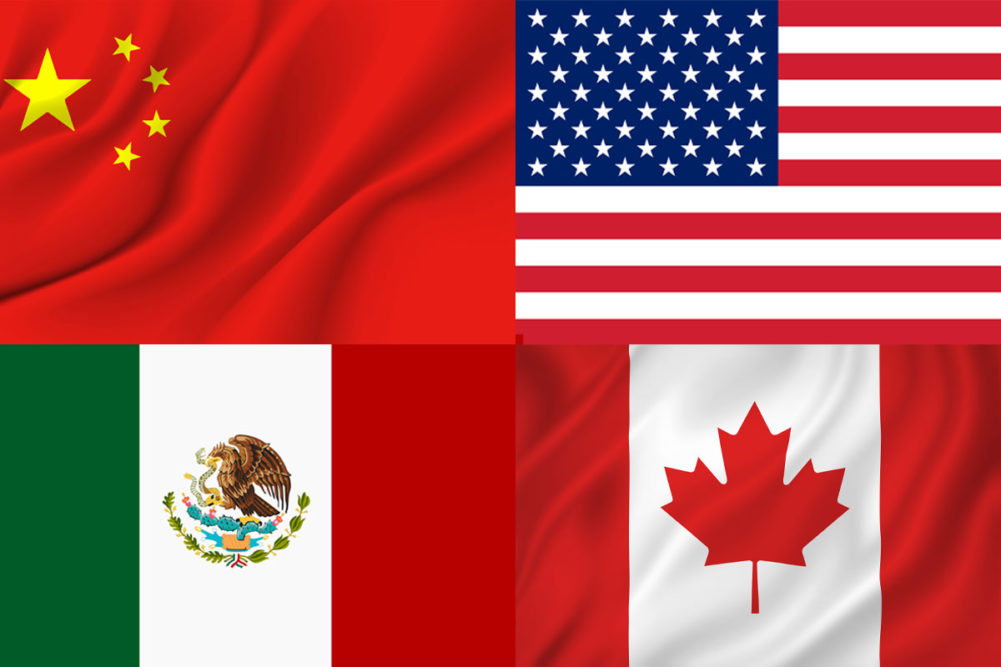
New tariffs on top US trade partners would make American agricultural goods harder to market abroad while simultaneously raising costs for farmers, food manufacturers and consumers, if recent threats made by President-elect Donald Trump come to fruition, according to agriculture industry groups.
In comments bookending the Thanksgiving holiday week, Trump on his Truth Social platform promised on day one of his administration a variety of moves, including a 25% across-the-board tariff on goods imported from Mexico and Canada; an additional 10% tariff on all Chinese imports; and a 100% tariff on imports from BRICS nations.
Some of the proposed tariffs were overlapping, and it was unclear whether Trump’s statements were related to planned policies or if they were meant as a negotiating tactic. Trump said the new tariffs would be aimed at reducing the flow of illegal immigrants and drugs from Mexico, Canada and China, and protecting the US dollar from currency manipulations among the BRICS bloc as a means of bypassing Western sanctions against nations including Russia and Iran, two BRICS members.
“The threat of massive tariffs on our top trading partners certainly grabbed the attention of farmers everywhere,” said Sam Kieffer, vice president of public policy at the American Farm Bureau Federation. “When tariffs are levied by the United States, foreign governments often target American agricultural exports for retaliation. In fiscal year 2024, Mexico became our No. 1 destination for American agriculture exports for the first time ($30 billion). Canada was No. 2 ($29 billion) and China was the No. 3 destination of exported US ag products ($25.7 billion).”
Together, those three countries shipped more than $1 trillion in goods to the United States from January through September of this year, according to the US Commerce Department. Mexico led the way with $379 billion, followed by China at $322 billion and Canada at $309 billion. Mexico and Canada have combined for $688 billion in US imports this year, outpacing the entirety of Europe ($565 billion). During the same period, US exports were $264 billion to Canada, $253 billion to Mexico and $105 billion to China.
Among agricultural goods, in 2023 the United States imported 16,993,971 tonnes from Mexico worth $45.5 billion, according to US Department of Agriculture data. Top categories included fresh fruits and vegetables — about two-thirds of all US vegetable imports come from Mexico — sugar, dairy products and distilled spirits like tequila.
Meanwhile, last year Mexico imported 40,453,901 tonnes of US agricultural goods worth $28.6 billion. Mexico is the No. 1 importer of US corn and corn sweeteners, leaving American corn farmers particularly exposed to retaliatory tariffs.
To the north, US agricultural imports from Canada in 2023 totaled 23,606,835 tonnes worth $40.1 billion, with top commodities including beef, pork, dairy products, oats and rapeseed oil. On top of that, Canada exports large quantities of energy products to the United States, with any retaliatory tariffs from Canada increasing fuel and production costs for US farmers. The United States bought more than $177 billion worth of oil and natural gas products from Canada last year, and crude imports from Canada make up more than one-fifth of all the oil US refineries process.
On the export side, last year US agricultural producers sent 14,501,562 tonnes of products worth $14.5 billion to Canada, with poultry, dairy, corn and soybean meal among leading commodities. Overall, more than three-quarters of Canadian export goods flow into the United States, with half of Canada’s imports coming from US producers each year.
Fertilizer inputs also represent an important portion of the US-Canada trade balance sheet.
“The United States imports a significant amount of agricultural fertilizer from Canada, including 87% of all potash imports,” Kieffer said. “While the cost of fertilizer has decreased somewhat in the last two years, farmers are paying up to 46% more for fertilizer today than at the beginning of 2020. Policies that would cause fertilizer prices to skyrocket again would have a ripple effect throughout the food system.”
Trump’s threats of a renewed trade war between North America’s three largest nations have precedent from his first term in the White House. In 2018, new Trump tariffs prompted retaliatory action from Canada and Mexico against US agricultural products.
“Canada imposed tariffs of 10% on goods, including prepared food products, coffee and orange juice,” said Stephen Morgan of the Economic Research Service (ERS) of the USDA. “Mexico imposed tariffs ranging from 15% to 25% on products, including pork, fresh and processed fruit and processed vegetables.”
That showdown led to the signing of the US-Mexico-Canada Agreement (USMCA), which took effect in July 2020 and replaced the North American Free Trade Agreement (NAFTA). Any new tariffs imposed by the incoming Trump administration seemingly would violate the USMCA, which Trump has said he wants to renegotiate. Since the latest tariff comments, Canadian Prime Minister Justin Trudeau and Mexican President Claudia Sheinbaum have reached out to Trump to gauge his intentions.
Then there’s China. In recent comments, Trump has said he wants to put in place an additional 10% tariff on all Chinese goods, as well as an extra 100% tariff on China for its role in purported BRICS bloc attempts to undermine the value of the US dollar. BRICS is an intergovernmental organization of nine countries: Brazil, Russia, India, China, South Africa, Iran, Egypt, Ethiopia and the United Arab Emirates.
In 2023, the United States exported 42,145,105 tonnes of agricultural products worth $29.1 billion to China, with China the No. 1 importer of US soybeans (26,600,892 tonnes), leaving soybean farmers especially exposed to any Chinese retaliation. Other top US exports to China include poultry, corn and animal feed. China’s retaliation against tariffs Trump enacted in 2018 cost US agriculture more than $27 billion, according to the ERS.
On the import side, the United States is much less reliant on China for agricultural products, buying just 2,317,161 tonnes worth $4.7 billion in 2023. One of its leading imports from China is used cooking oil (UCO), with more than half of current UCO imports originating from there. While Chinese tariffs on imports would hurt US soybean farmers overall, the soybean oil industry could see a boost if the spigot of Chinese UCO were shut off by increased tariffs and the end of government incentives put in place by President Joe Biden’s administration.
“It remains to be seen whether this is a negotiating tactic or a foregone conclusion, but any final decision must take into consideration the impact on farm families at a time when the United States has lost more than 140,000 farms in five years,” Kieffer said.
US households should expect to feel the weight of new tariffs, too. When importers pay additional costs to purchase goods from abroad, they typically pass those costs along to producers and consumers. Trump’s tariff proposals would cost the typical American household $2,600 per year or more, according to a recent report by the Peterson Institute for International Economics, a nonpartisan thinktank. The 100% tariff Trump proposed for BRICS countries after the report’s publication would only add to that.
After China, the top BRICS trade partners with the United States are India and Brazil. India exported 1,172,117 tonnes of agricultural products to the United States last year, according to the USDA, with dairy, vegetables and rice among top commodities. Those were worth $3.1 billion, compared with $1.9 billion in US exports to India, which included animal feed, fruits, nuts and oilseeds and oilseed products. During the same period, Brazil exported 2,412,824 tonnes of agricultural products worth $6.2 billion to the United States, led by beef, dairy, orange juice and corn. Leading US exports to Brazil, worth $700 million, were poultry, meat, dairy and animal feed.
“The agricultural economy is struggling, which means farmers are already experiencing significant financial stress from inflated supply costs and decreasing prices for their products,” Kieffer said. “Now is not the time to send shock waves through the agricultural economy.”
You can now read the most important #news on #eDairyNews #Whatsapp channels!!!
🇺🇸 eDairy News INGLÊS: https://whatsapp.com/channel/0029VaKsjzGDTkJyIN6hcP1K

























